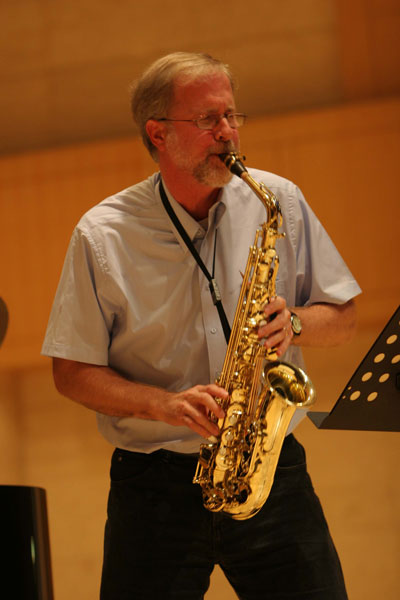 computers—especially computers-- and many other interests could be discussed. Over the next few years, some of my friends at
universities around the country obtained email and long-distance, almost
instantaneous, email communication became possible.
Before long, the Internet went graphical. It was quickly populated with thousands of
commercial sites. In fact, there was so little
content of interest online, I dismissed it as just a big advertising venture. It was easy to ignore. A few yeas later, in the early 90s, I began a hobby of writing
web sites using the HTML programming language.
I never did anything serious with this until 2005 when I created the
University of Florida Saxophone Studio web site. This site is based on a template provided by
the university that I highly customized by editing the HTML code. I continue to maintain this site by editing
the HTML. http://www.arts.ufl.edu/music/saxophone/
computers—especially computers-- and many other interests could be discussed. Over the next few years, some of my friends at
universities around the country obtained email and long-distance, almost
instantaneous, email communication became possible.
Before long, the Internet went graphical. It was quickly populated with thousands of
commercial sites. In fact, there was so little
content of interest online, I dismissed it as just a big advertising venture. It was easy to ignore. A few yeas later, in the early 90s, I began a hobby of writing
web sites using the HTML programming language.
I never did anything serious with this until 2005 when I created the
University of Florida Saxophone Studio web site. This site is based on a template provided by
the university that I highly customized by editing the HTML code. I continue to maintain this site by editing
the HTML. http://www.arts.ufl.edu/music/saxophone/
Since then, I’ve read a lot more on HTML, XHML, CSS, web design, information architecture, etc., and I've created a few more web sites:
► An individual account at UF which serves as an index to
my various professional pursuits, and hosts some documents for the Executive
Committee of the North American Saxophone Alliance. http://plaza.ufl.edu/jhelton/
► A site for my duo, http://plaza.ufl.edu/jhelton/saxcello/
This site has proven very useful for marketing the duo for concerts and tours
worldwide. I created this site from a generic template for a two-column
page layout. This took a bit more work than my earlier sites since this
template was very basic and included no content or placeholders.
► The Onyx Saxophone Quartet site: http://plaza.ufl.edu/jhelton/onyx/index.html This was the first site I composed entirely from scratch. I now see a lot of room for improvement here, but am not sure when I'll find the time to get back to it. I spent a lot of time making the graphic buttons and header image.
► Recently, I created http://www.jonathanhelton.com.
This site was created on the Blogger Blog site using their content management
system. It is easy to set up, customize and run a blog at blogger.com,
but it took a lot of work to edit it so it looks and acts like a “normal” web
site.
► I’ve also created a new site for the
Duo at: http://heltonthomasduo.blogspot.com/
Another adapted blog site.
 |
| Original duo site. |
 |
| New duo site. |
Last week’s project was to re-create my personal site
(jonathanhelton.com) for use on another web server. The blogger-based site is rather
complicated. It has all the code in one
file and uses a number of convoluted if/then statements, javascript, etc. to
display the different “pages.” Plus,
there’s all that blog code that I don’t need for my site. The design is pretty straightforward, so I
thought I could clone it by writing code from scratch. After a bit more research and several hours
of trial and error, I think I’ve succeeded.
Take a look at my clone site at: http://plaza.ufl.edu/jhelton/jh/index.html
The tricky parts were:
► The navigation buttons. Emulating the look and function of those on the
blogger site took some work. I knew the
basic CSS technique of creating navigation buttons from an unordered list, but
getting everything to line up, getting the entire “button” to change colors
when you hover the mouse over it, making the entire box clickable, hiding the
dotted outline that appears around the link when you return to a page, making
the borders look good, matching, colors, etc. all took some time.►Aligning the CD images on the discography page with the associated text also took a few minutes to figure out. The text and the images all wanted to behave their own way. A few CSS class designations later, and now it works great!
The rest of the design was pretty straightforward. It was a good XHTML/CSS project. I gained a much better understanding of how to position and format things with CSS, creating a clean, useful, and standards-based, web site.




1 comment:
Gotta get back to practicing!!
:)
Post a Comment